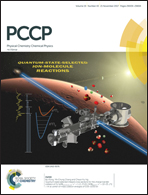Investigation of energy band alignments and interfacial properties of rutile NMO2/TiO2 (NM = Ru, Rh, Os, and Ir) by first-principles calculations
Abstract
In the field of photocatalysis, constructing hetero-structures is an efficient strategy to improve quantum efficiency. However, a lattice mismatch often induces unfavorable interfacial states that can act as recombination centers for photo-generated electron–hole pairs. If the hetero-structure's components have the same crystal structure, this disadvantage can be easily avoided. Conversely, in the process of loading a noble metal co-catalyst onto the TiO2 surface, a transition layer of noble metal oxides is often formed between the TiO2 layer and the noble metal layer. In this article, interfacial properties of hetero-structures composed of a noble metal dioxide and TiO2 with a rutile crystal structure have been systematically investigated using first-principles calculations. In particular, the Schottky barrier height, band bending, and energy band alignments are studied to provide evidence for practical applications. In all cases, no interfacial states exist in the forbidden band of TiO2, and the interfacial formation energy is very small. A strong internal electric field generated by interfacial electron transfer leads to an efficient separation of photo-generated carriers and band bending. Because of the differences in the atomic properties of the components, RuO2/TiO2 and OsO2/TiO2 hetero-structures demonstrate band dividing, while RhO2/TiO2 and IrO2/TiO2 hetero-structures have a pseudo-gap near the Fermi energy level. Furthermore, NMO2/TiO2 hetero-structures show upward band bending. Conversely, RuO2/TiO2 and OsO2/TiO2 hetero-structures present a relatively strong infrared light absorption, while RhO2/TiO2 and IrO2/TiO2 hetero-structures show an obvious absorption edge in the visible light region. Overall, considering all aspects of their properties, RuO2/TiO2 and OsO2/TiO2 hetero-structures are more suitable than others for improving the photocatalytic performance of TiO2. These findings will provide useful information for understanding the role and effects of a noble metal dioxide as a transition layer between a noble metal co-catalyst and a TiO2 photocatalyst.



 Please wait while we load your content...
Please wait while we load your content...